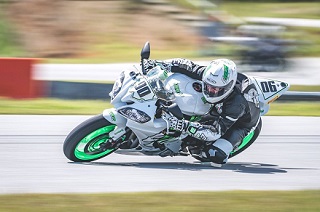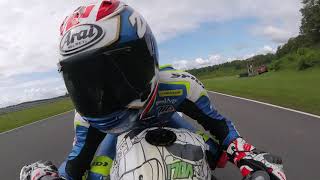Choosing the right helmet for track days is essential for your safety and comfort on the race track. There are several factors to consider when selecting a helmet for track use, including safety certifications, helmet type, fit, and additional features.
Here is a detailed guide to help you choose the right helmet for track days. Let’s begin!
Choosing the Right Helmet for Track Day Triumphs
Selecting the perfect helmet is crucial for both safety and comfort during the exhilarating world of track days. Here’s a breakdown of key factors to consider:
1. Safety Certifications:
Getting on the track is exhilarating, but safety is paramount. Your helmet is your first line of defense in a crash, so selecting the right one with proper certification is essential. Here’s why certifications matter:
- Rigorous Testing: Certified helmets undergo a battery of tests to simulate real-world impacts. These tests measure the helmet’s ability to:
- Absorb impact energy, protecting your head from blunt force trauma.
- Mitigate rotational forces, which can cause serious brain injuries.
- Maintain structural integrity, preventing the helmet from breaking apart.
- Standardized Safety: Certifications ensure all helmets meet a minimum safety threshold. This allows for easy comparison between different brands and models.
- Recognized Standards: Look for helmets certified by reputable organizations like:
- Snell Memorial Foundation: Known for their stringent testing standards, exceeding some minimum requirements.
- FIA (Fédération Internationale de l’Automobile): Focuses on motorsports safety, including helmets for track use.
- ECE (Economic Commission for Europe): Widely recognized European standard for motorcycle helmets.
Choosing the Right Certification:
While each certification offers excellent protection, some cater to specific needs:
- Snell: Ideal for track day enthusiasts seeking the highest level of protection.
- FIA: Perfect for those participating in organized track events with FIA regulations.
- ECE: A solid choice for general track day use, ensuring compliance with European safety standards.
Remember: Certifications are just one factor. A properly fitted helmet is crucial for optimal protection. Ensure the helmet feels snug and comfortable, without any pressure points.
2. Helmet Types:
When it comes to track day helmets, safety is paramount. While there are various helmet styles available, for the racetrack, a full-face helmet is the undisputed champion. Here’s why:
- Maximum Protection: A full-face helmet encases your entire head, including the crucial jaw area. This offers the highest level of defense in case of a crash or debris impact.
- Reduced Wind Noise: At high speeds on a track, wind noise can be distracting and tiring. A full-face helmet creates a quieter environment, allowing you to focus on the ride.
- Enhanced Aerodynamics: Full-face helmets are designed to minimize wind resistance and drag. This translates to better stability and control, especially at high speeds on straightaways and corners.
Open-Face vs. Full-Face: A Clear Choice
Open-face helmets, while popular for cruising, leave your face exposed. On a track, this is a significant safety risk. Even minor debris or an insect strike at high velocity can cause serious injury.
Modular Helmets: A Compromise (with limitations)
Modular helmets offer the convenience of a flip-up chin bar, allowing for easier communication or drinking fluids during breaks. However, they may not be as aerodynamic or structurally strong as a dedicated full-face helmet, potentially compromising safety on the track.
The Final Lap: Full-Face for the Win
While some tracks might allow open-face helmets with specific certifications, for optimal safety and performance on a track day, a full-face helmet is the clear winner. It prioritizes your well-being and allows you to focus entirely on the exhilarating experience of pushing your limits on the racetrack.
3. Fit and Comfort:
A properly fitting helmet is essential for maximizing safety and enjoyment on the track. Here’s how to ensure your helmet becomes a trusted companion, not a bothersome burden.
Measure Up:
- Head Size Matters: Grab a soft measuring tape and measure the circumference of your head just above your eyebrows and ears. This measurement will be your starting point for finding the right size helmet according to the manufacturer’s sizing chart.
Beyond the Numbers:
- The Snug Test: Size isn’t everything. The helmet should feel snug and secure without creating pressure points. A slight cheek squeeze when putting it on is normal, but it shouldn’t be uncomfortable.
- Shake it Off (Not Really): With the chin strap fastened securely, give your head a good shake. The helmet shouldn’t shift or wobble excessively.
Brand Matters Too:
- Finding Your Match: Head shapes vary, and so do helmet interiors. Trying on different brands and models is crucial to discover the one that best conforms to your head shape. What feels perfect for your friend might not be ideal for you.
Comfort is Key:
- Padding Power: The quality and feel of the padding significantly impact comfort. Look for plush, breathable materials that wick away moisture to keep you cool and focused during intense sessions.
Remember: Safety and comfort go hand in hand. By following these steps, you’ll find a helmet that fits like a glove, allowing you to concentrate on pushing your limits on the track, not worrying about your headgear.
4. Additional Features:
Hitting the track is an exhilarating experience, but staying cool and focused is key to a successful (and safe) day. Here’s how your helmet can be your best friend on the track:
- Beat the Heat: Track sessions push your body, and your head is no exception. Look for a helmet with well-placed vents that channel air throughout the shell. These vents shouldn’t compromise aerodynamics (stability at high speeds) or create excessive wind noise.
- Crystal Clear Vision: A good track helmet prioritizes visibility. Choose one with an adjustable visor that offers a wide field of view so you can see everything around you. Anti-fog properties are essential to prevent a blurry mess during humid conditions. A quick-change visor mechanism allows you to swap visors quickly for different weather or lighting situations.
- Stay Connected: Track days often involve riding with others. If you plan to use a communication system to chat with fellow riders or your pit crew, look for a helmet with built-in speaker pockets and microphone compatibility. Some helmets even have dedicated cutouts for specific communication systems.
By prioritizing these features, your helmet becomes a vital part of your track day arsenal, keeping you cool, focused, and connected throughout your ride.
5. Budget Considerations:
You’re absolutely right. Track helmets come in a wide price range, and finding the right balance between safety, comfort, and affordability is key. Here’s a breakdown of what to consider:
Safety First:
- Certifications: Look for helmets that meet safety standards set by organizations like Snell Memorial Foundation (SMF) or DOT (US Department of Transportation). These certifications indicate the helmet has passed rigorous impact tests.
- Material: Helmets are typically made of fiberglass, composite materials, or polycarbonate. Higher-end helmets often use a mix for optimal strength and weight.
Considering Your Needs:
- Comfort: A good helmet should fit snugly but comfortably. You’ll be wearing it for extended periods on the track, so proper fit is crucial to avoid fatigue and pressure points.
- Ventilation: Good airflow helps prevent overheating and keeps you focused. Look for helmets with vents that can be opened and closed to adjust airflow.
- Visor: A high-quality, scratch-resistant visor with a quick-change mechanism is ideal for optimal visibility and easy replacement during the day.
- Additional Features: Some helmets offer features like tear-off tabs for the visor to keep your vision clear, a built-in hydration system, or noise-cancellation technology. These can enhance your track day experience but will affect the price.
Budget vs. Long-Term Investment:
- While a lower-priced helmet might seem attractive, a higher-quality helmet offers advantages:
- Durability: A well-made helmet can last for many years, saving you money in the long run.
- Safety: Better materials and construction offer superior protection in case of a crash.
- Comfort: Higher-end helmets often have better fit and ventilation systems, reducing fatigue.
Finding the Right Balance:
- Set a realistic budget for your helmet.
- Prioritize safety features and certifications that are non-negotiable.
- Look for helmets within your budget that offer a good balance of comfort and features you find important.
- Consider buying a pre-owned helmet from a reputable source to save money, but ensure it’s in excellent condition and hasn’t been in a crash.
Remember, your helmet is the most crucial safety gear on the track. Don’t compromise on protecting your head!
Conclusion:
Choosing the right helmet for track days is a crucial decision for your safety and comfort on the race track. Ensure that the helmet meets the necessary safety certifications, such as Snell or FIA, and consider factors like helmet type, fit, and additional features.
Opt for a full-face helmet for maximum protection, ensure a comfortable and secure fit, and assess features like ventilation and visor options. Remember to prioritize safety and reliability over cost when choosing a helmet for track days.
To get an experience of proper riding, book a training session with EvolveGT now!




